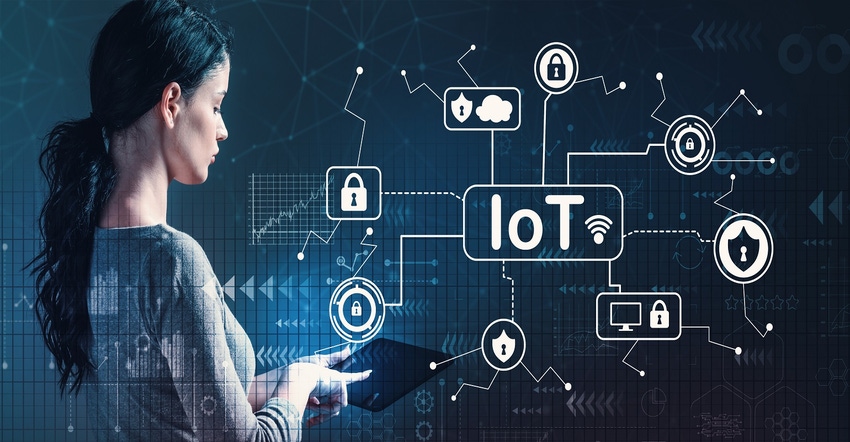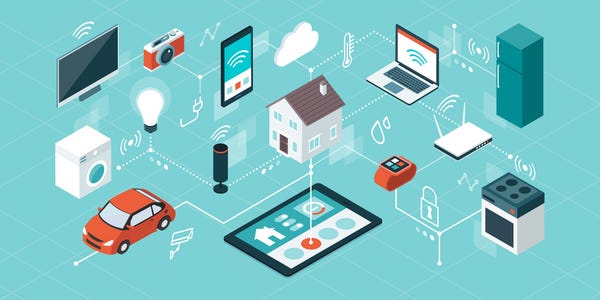Industry Voices: Digi-Key Points to IoT as Key to Effective Automation
As IoT becomes less expensive and simpler to use, it is growing beyond factory automation.
May 10, 2021

Initially, IoT systems were difficult to deploy and the costs were pricey. Yet the efficiencies provided by IoT made it nearly essential for plants and facilities. The ability to detect that equipment was nearing failure – and to catch the issue before that failure – was nearly priceless as IoT delivered increases in uptime and decreases in costly downtime.
These days, those expensive IoT systems cost less and are easier to deploy. Consequently, we’re seeing IoT getting deployed in a wide range of industries, from medical care to agriculture. We caught up with Robbie Paul, director, IoT business development at Digi-Key Electronics, to get his take on the continuing expansion of IoT.
Design News: What industries are deploying IoT systems?
Robbie Paul: Products are becoming smarter and more connected at a rapid pace. We are seeing growth across many IoT verticals. This is being driven by simpler platforms -- both cloud-based and on-premises – and software that is easier to implement.
As the costs of implementing IoT solutions decrease, more applications and use cases are enabled. At Digi-Key, we continue to see the agricultural and industrial segments holding a great deal of promise over the coming years.
IoT solutions are also taking automation to the next level with the use of artificial intelligence and machine learning. Autonomous tractors and general-use robots are becoming more common and have a real impact on improving productivity and cost savings.

DN: What are the needs that are getting addressed? Predictive maintenance? Asset tracking?
Robbie Paul: Any opportunity where performance and productivity can be improved, or where costs can be reduced, are ripe for IoT adoption. Here are a few examples:
Huge improvements in up-time and significant reductions in costs with predictive maintenance in the industrial space
Time and money saved with asset trackers in the logistics space
Improved safety and more accurate compliance with cold chain monitoring in the retail space
And the list goes on! The opportunities around IoT are nearly endless.
DN: What types of sensors are involved? Vision? Temperature? Vibration? Asset tracking?
Robbie Paul: Environmental monitoring sensors (such as temperature, humidity, pressure, etc.) are still among the top-performing products at Digi-Key.
Cameras are also taking off in popularity as machine learning software improves at a seemingly exponential pace. Image processing and recognition are rapidly being adopted in factories and warehouses.
DN: What technical people are usually involved in IoT? Systems management? Electrical engineers? Mechanical engineers?
Robbie Paul: IoT product development requires people from multiple disciplines, including electrical and mechanical engineering, as well as those with firmware and software expertise. Successful IoT product development requires a team of technical experts.
The team also needs to possess specific knowledge of application areas or use cases. For example, if you’re developing a solution to improve productivity on a farm, you need to know and understand the pain points a farmer faces.
DN: What is Digi-Key’s role in IoT? Offering new equipment? Field engineering. On-phone/online experts?
Robbie Paul: Digi-Key’s foundation has always been with electronic components, usually at the board level. With the IoT business, we have taken a different approach by focusing on systems and solutions.
Given Digi-Key’s diverse customer base, our vision is to offer products that cover all levels of integration. This starts with components and modules (sensors, micro-controllers, and connectivity), and now includes finished devices that are ready to deploy in the field. We are starting to offer more integrated solutions that include software and platforms that enable device management, data visualization, and cloud storage. We are also selling SIM cards and cellular data plans as add-on options.
Digi-Key offers engineers countless resources with the new Digi-Key IoT Resource Center. Using these resources can help innovators navigate the plethora of choices and find the best solutions for their applications or use-cases.
DN: Who is deploying IoT? Inhouse engineers? System integrators?
Robbie Paul: That depends on several factors. The primary consideration is complexity. In-house engineers may not have the expertise to deploy a complete IoT solution that involves hardware, software, and services. Having a systems integrator to help with the installation and commissioning makes sense most of the time. Also, we have noticed that systems integrators are playing bigger roles as more ready-to-deploy finished devices become available on the market. More configurable solutions are also becoming popular as system integrators can customize a platform for the specific application.
DN: How has the pandemic affected IoT?
Robbie Paul: If anything, the COVID-19 pandemic has accelerated the creation and deployment of IoT solutions. For example, we have recently seen many new solutions around crowd control and social distancing. These solutions were created in record time and used in retail stores, restaurants, and workplaces. Digi-Key itself deployed a Bluetooth and LoRa based contact tracing solution in our warehouse, which allows Digi-Key to quickly determine if any employees have been in contact, or proximity, to a colleague who later tested positive. All of this was done while preserving privacy and security.
DN: Where do you see the future of IoT? Greater connectivity of IoT systems? Data analytics?
Robbie Paul: The fun part of working in the IoT space is the relentless pace of innovation. Better solutions that are easier to deploy and use on an ongoing basis are constantly being developed. On the hardware side, sensors and micro-controllers continue to get smaller and cheaper.
The real innovation, in my opinion, is happening around connectivity. 5G low-power wide-area networking (LPWAN) protocols, like Cat-M and NB-IoT, are getting wider coverage and becoming less expensive.
Another LPWAN protocol that is giving 5G a run for the money is LoRaWAN. New business models using blockchain technology are being tested in the real world. Helium is one such company that is successful in rapidly expanding LoRa coverage with over 30,000 hotspots. The blockchain model allows for rapid expansion using a decentralized model and provides the incentives to keep the network running.
Rob Spiegel has covered manufacturing for 19 years, 17 of them for Design News. Other topics he has covered include automation, supply chain technology, alternative energy, and cybersecurity. For 10 years, he was the owner and publisher of the food magazine Chile Pepper.
About the Author(s)
You May Also Like


.jpg?width=300&auto=webp&quality=80&disable=upscale)


